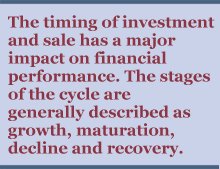

|
207 Abbey Lane Lansdale, Pennsylvania 19446 215-855-1800 |
5201 Ocean Avenue #2007 Wildwood, New Jersey 08260 215-990-6663 |
Specializing in Real Estate Appraisal and Property Tax Consulting
A Professional Courtesy of:
|

Specializing in Real Estate Appraisal and Property Tax Consulting |
| WINTER 2010 |
 |
|
In This Issue: |
|
Risk and Real Estate As recent events have amply demonstrated, investment in income-producing real estate carries considerable risk. There are many sources of such risk, both intrinsic and extrinsic to the property. Such risks accrue to both equity and debt positions in any given property. A partial list of risks follows, taken in part from The Appraisal of Real Estate (12th edition). There are, of course, other possible risks, many of which are not foreseeable and/or improbable. Market risk Market risk has to do generally with changes in supply and demand. For example, due to lower lease and occupancy rates, the emergence of oversupply will reduce net operating income (NOI). Conversely, an imbalance of demand over supply will have the opposite effect. The resulting decrease in risk may be short-lived because such an imbalance is likely to spur additional supply. Market risk factors vary by property type and location. Financial and capital market risk This element of risk centers around debt capital utilized on a property. Because income property investment is capital intensive, the importance of debt capital is great. From the lender's perspective, there are risks associated with default and fluctuating market interest rates. Such risks vary directly with loan-to-value ratios, debt coverage ratios, whether the loan is based upon a fixed or variable rate of interest, and whether the lender has recourse against assets other than the property that secures the mortgage. Lenders seek to reduce or eliminate losses from loan prepayment by imposing either "lock out" or yield maintenance provisions. From the perspective of the equity position, changes in interest rates on variable rate loans can pose serious risks (e.g., higher debt service reduces cash flow to equity and increases the likelihood of default). The existence of junior/mezzanine debt increases risk to both the debt and equity positions because relatively small decreases in effective gross income will have a large negative effect on NOI. Inflation risk This risk is defined as the "risk that unexpected inflation will cause cash flow from operations and reversion to lose purchasing power" (The Appraisal of Real Estate). Ownership typically seeks to ameliorate such risk by steps in lease rates over the term of lease, as well as by requiring lessees to bear expenses that increase over those in the first (base) year of the lease. Liquidity risk 
Liquidity as a source of risk has to do with one's ability to sell interests in real estate in a timely manner. Income-producing real estate is relatively illiquid vis-ą-vis publicly traded investment instruments. However, market conditions may exacerbate the degree of illiquidity. Contributors to this source of risk include the unavailability or cost of debt, as well as potential buyers' perceptions that a significant weakening of fundamentals is in the offing. Sellers' widespread unwillingness or inability to accept prices offered by potential purchasers is less an indication of illiquidity than of sellers' refusal to mark their properties' values to market. In such environments, few transactions occur. To reduce this risk, some investors (both debt and equity) choose to purchase interests in securitized debt instruments and real estate investment trusts. Environmental risk This risk relates to a property's physical environment. The discovery of hazardous materials on or adjacent to the property may impose onerous responsibilities upon ownership. Conversely, the reclamation of contaminated properties (e.g., brownfields) has been quite profitable for investors having such specialized expertise. Legislative risk This source of risk accrues from governmental actions (actual or anticipated), changes in property, and income tax law and environmental regulations, such as land use laws (e.g., zoning). In addition, there is often significant risk in obtaining all required permits for development projects. Such risks vary significantly among geographic areas. As a broad generalization, such risks are far smaller in economically weak areas than in those with strong economies and high demand for new development. When analyzing the potential value of a proposed development that has received all necessary permits, one must determine with certainty whether such permits are entity specific or can be transferred to new ownership upon sale. Management risk The financial performance of income-producing real estate is heavily dependent on the performance of management, the impact of which varies by type of property. The most management-intensive types of properties include health care facilities, hotels, resorts and regional malls. On the other hand, properties net leased for long terms require far less management. General observations It is well established that the aforementioned risks are inextricably related. Increasing interest rates diminish cash flow, which increases risks for both lenders and borrowers. Increasing rates of inflation are positively correlated with interest rates. The risk of increased taxes affects lease rates, NOI and after-tax yields. Changes in land use regulations may profoundly affect relative supply and demand in a particular area. Real estate risk is also closely correlated with both business and real estate cycles. The timing of investment and sale has a major impact on financial performance. The stages of the cycle are generally described as growth, maturation, decline and recovery. In the growth stage, market fundamentals are strong, and attractive debt capital is available. The general mood is positive. Current and forecast demand often exceeds supply. 
In the maturation stage, rental and occupancy rates have increased to at least historical levels. It is a "sellers' market," with buyers struggling to acquire property at yields consistent with historical norms. Prices have been bid up to levels that are above historical inflation-adjusted levels and thus not representative of the risks inherent in such investments. New development generally represents greater supply than can be justified by reasonable forecasts of demand. Lenders become more aggressive in their underwriting in order to maintain market share. In the declining stage of the cycle, supply typically exceeds demand, resulting in declining lease and occupancy rates. Consequently, market values decline, sometimes to the point of eliminating the value of the equity position in highly leveraged properties. Mortgage capital becomes subject to more stringent underwriting standards (lower loan-to-value ratios, increased interest rates, and an emphasis on the quality and durability of a property's NOI). In short, commercial real estate as an asset class falls into relative disfavor. The recovery stage generally commences when the aforementioned excesses have abated due to general economic growth, coupled with the "market clearing" actions of real estate market participants (i.e., sellers, buyers and lenders). Risk is thus reduced if one buys in the recovery and growth stages of the cycle and sells in the early part of the mature stage. At such points, one is generally able to absorb negative occurrences far better than in either the mature or declining stages of the cycle. Conversely, there is typically little margin for miscalculation in the mature and declining stages of the cycle, unless one has adequately modeled diminished expectations of future performance. This is indeed rare because sellers are usually unwilling to accept such lowered expectations at these points in the cycle, opting instead to await for either better offers (mature market conditions) or better market conditions (declining market conditions). When considering real estate risk, one should always be aware that incomeproducing real estate has value only because of its ability to provide economic utility to its users. The foregoing risk discussion centers on factors specific to real estate. However, national and international influences may (and frequently do) have profound effects on real estate value. In short, an almost unknowable number of factors influences risk in real estate. The single most important means of ameliorating such risk lies in the timing of the investment. |
Supply and Demand: A Different Perspective Real estate values are most stable in situations where supply and demand are in equilibrium. Prices tend to vary directly with increases in demand and inversely with increases in supply. The estimation of supply is relatively straightforward. There are numerous published sources of current inventory (expressed as square footage, units or rooms) of most types of commercial property. Further, local governmental data regarding planned additions to supply, as well as properties under construction, are readily attainable. 
The degree to which existing supply is occupied is evidence of current demand. Space that is leased but available for sublease is considered vacant for purposes of demand analysis. In forecasting, the future relationship between changes in supply and demand is the crux of the matter. One can reasonably project that supply will be increased to meet demand, assuming (a) the availability of land upon which to build and (b) the ability to obtain governmental approvals/permits. If either is unlikely, it is reasonable to expect an excess of demand over supply and, hence, greater increases in rental and occupancy rates than would otherwise be the case. During periods of excess liquidity, excessive additions to supply may be anticipated, based on the old saw that "given mortgage money, developers will fill the world with empty buildings." There are temporal differences between supply and demand. The time required to construct new supply (i.e., buildings) is far longer than the time during which significant shifts in demand may occur. It is the accurate forecast of demand that is often given short shrift. A linear forecast of demand growth based on historical data will almost surely lead to error. Unexpected, large increases in demand have no significant negative implications except from the perspective of tenants, who must bear higher occupancy costs. However, marked declines in demand bode ill for property owners, developers and lenders. In such forecasts, the impact of diminution in demand is seldom fully appreciated. It must be remembered that income property has no intrinsic worth in and of itself. Rather, its value is created and sustained by its ability to provide economic benefits to its users. When, for example, consumers reduce spending in retail stores, the negative effects to such retailers are almost invariably passed on to lessors. When making such forecasts of supply and demand, one must be cognizant of the phases of the business and real estate cycles at the time of the analysis. This rarely happens in practice for reasons described in the previous section. However, the failure to allow for future reductions in demand in the mature and declining stages of the cycle will lead to poor decisions, regardless of the accuracy of supply forecasts. |
Real Estate and Capital Markets Real estate is clearly a capital intensive asset type. The industry is, therefore, closely tied to debt and equity capital, available through the capital markets. Because of its dependence on the capital markets, changes in the latter have a demonstrable effect on the former. Since the latter part of 2007, the capital markets have been unaccommodating to the needs of the real estate industry. Several reasons account for this, including the perception that commercial real estate reached unsustainably high price levels, was overleveraged and offered unacceptably low returns given the risk involved. 
The debt markets have adjusted to these perceptions by requiring far greater amounts of equity in proportion to debt and a stable occupancy (in terms of both occupancy rates and the financial strength of the tenancy). The real estate sector worldwide is in a protracted period of deleveraging. Equity value has been diminished or eliminated. Because of sharp declines in value, existing debt cannot be financed without the infusion of considerable capital. For many equity investors, this is not possible. While this situation has been catastrophic for many investors, it also represents great opportunity for those able to capitalize on it. Many properties will be acquired for prices that are 40% to 50% below the cost levels of 2007. |
Litigation Support Real estate valuation professionals are well trained to assist clients during this turbulent time. Litigation support involves a variety of services, including consulting expertise to counsel, review of opposing experts' reports, and expert testimony in depositions and trial. In such matters, valuation professionals must be quite clear as to the role they are assuming. Such professionals may assist in the critique of opposing expert's reports in the role of consulting experts. In such cases, however, the professional must provide such services without advocacy. In matters involving expert testimony, the professional valuer typically takes on the role of an independent expert, without advocacy for any position other than his or her own. The essential point is that the professional must not offer services in ways that may mislead. |
Home | Newsletters | About Us | Contact Us |